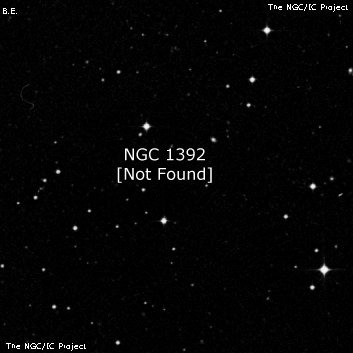NGC/IC Project Restoration Effort
(This is a very very beta version)
NGC1392


Basic Information
Location and Magnitude
Right Ascension: 3:37:30.3
Declination: -37:8:5
Constellation: ERI
Visual Magnitude:
Historic Information
Discoverer: Swift L.
Year of discovery: 1887
Discovery aperture: 16.0
Observational
Summary description: vF, pS, R
Sub-type: NF
Corwin's Notes
=====
NGC 1392 was found by Swift on 13 February 1887 about 4 arcminutes north of a
brighter "nebula" which he took to be Comet 1887-I, three degrees south of
its predicted position. There is nothing in either of the places given by
Swift in his sixth list for either object. Nor is there anything three
degrees north where the comet was supposed to have appeared that night.
However, the center of the Fornax cluster is one and a half degrees north. I
think it's likely that Swift saw two of the galaxies there, but choosing two
out of the 15-20 that he could have seen would be pure guesswork. Similarly,
Lauberts's guess in ESO (ESO 358-G040) is based on a reliance on the 1 degree
difference in declination more than it is on the likelihood that Swift
actually saw the object: ESO 358-G040 has a total visual magnitude around
16.2, likely putting it beyond Swift's limit, especially given the far
southern declination.
A third possibility is raised by Kreutz in a note following Swift's list in
AN. Kreutz notes that the offset of Swift's position from that predicted for
the comet by Finlay is 38 minutes east, and 4 degrees 1 arcminute south.
However, searching at Finlay's place for a double nebula turned up nothing,
either.
Other objects found by Swift on the same night include NGC 1797 and NGC 1799,
both very near Swift's positions for them; and NGC 2589, like NGC 1392, not
found at Swift's position (see Herbert Howe's note in MN 61, 29, 1900, copied
into the IC2 Notes).
In the end, NGC 1392 is another of Swift's nebulae "not found."
-----
Comet 1887-I does not appear, by the way, in a 10x10 degree square centered on
Swift's position during the time of his observation, at least using JPL's
"Small Body" identification tool. Nor does it appear near Kreutz's place.
So, this is either a lost comet, or its orbit was not well-known in 1887 -- or
both.
The only comet near Swift's position on the date of his observation (assuming
a time of 21:00 EST) is "C/1968 H1 (Tago-Honda-Yamamoto)" at 03 30 50,
-39 57.3. But at this point in its orbit, it had a predicted total V
magnitude of 39.6, well beyond (!) the limit of Swift's 16-inch refractor.



